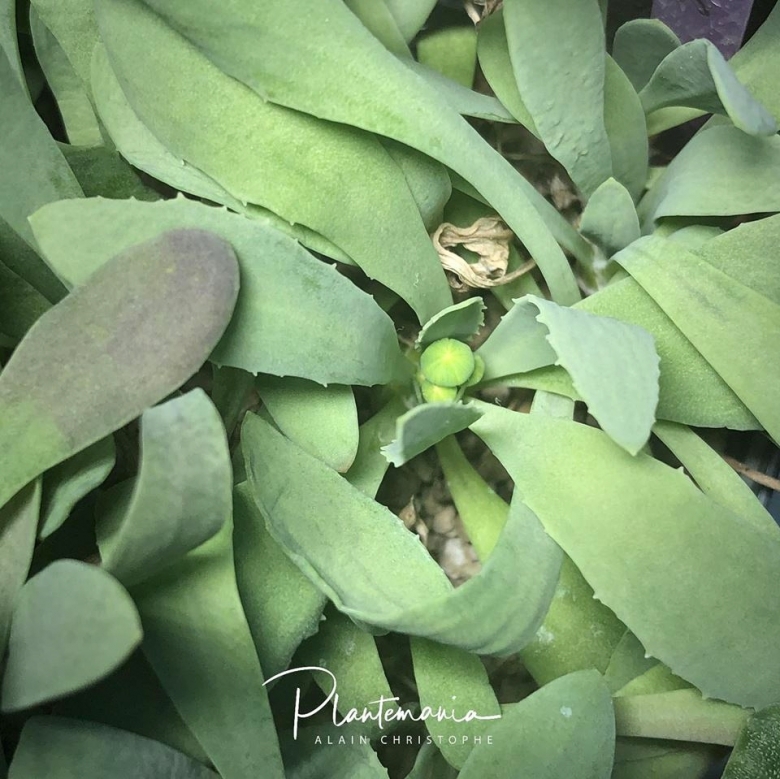




Your support is critical to our success.

Origin and Habitat: South Africa, Northern Cape (Little Namaqualand, Komkans near Vredendal and Knersvlakte.) Othonna lepidocaulisSN|35524]]SN|35524]] is a range-restricted habitat specialist (extent of occurrence less than 320 km²), it is known from fewer than than five sites.
Habitat and Ecology: Succulent Karoo. O. lepidocaulis is amongst the rarest of South Africa's Othonna species. It grows on on low undulating hills, mostly on south, east and southeast-facing slopes, more rarely on the summits and upper west-facing slopes, on patches of white quartz pebbles over very alkaline (brak) soil. At some localities it is plentiful locally, whilst rather sparse at others. This habitat harbour a rich succulent flora comprising Crassula barklyiSN|26577]]SN|26577]], Jacobsenia vaginata, Monilaria scutata, Conophytum maughaniiSN|22606]]SN|22606]] ssp. armeniacum, Anacampseros papyraceaSN|11043]]SN|11043]] ssp. namaensis just to cite some. It is dormant in summer (from November to May) which is the hottest and driest time. The plants are leafless at this time.The growth cycle starts in autumn when the first rains fall and the plants flower in winter (July). Fertile seed is set in late winte to early spring (August-September) just before entering in dormancy. Seed may germinate in spring if the weather is cool with some rain. During years with a dry spring the seeds obtains the chance to germinate in autumn. O. lepidocaulis grows in the most barren areas which hardly merit the attention of grazing animals. Pastoralism presently seems to pose no problems. There are no other threats to this species.
Synonyms:
- Othonna lepidocaulis Schltr.
Description: Othonna lepidocaulisSN|22893]]SN|35524]], the scaly othonna, is a miniature deciduous little-branched shrublets to about 23 cm tall. It has a golden caudiciform trunk with numerous tightly packed fish scales, markings where the leaves of previous seasons have dropped off. It is hardly succulent. Deciduous in summer, it grows new leaves with the onset of the winter rainy season when it also flowers. The flowers are small yellow daisies with narrow ray florets appearing in sprays on long stalks well above the leaves This species and Othonna herreiSN|35524]]SN|22893]] vie closely with one another as the most impressive species in the genus Othonna.
Derivation of specific name: The epithet “lepidocaulis” comes from the Greek word “lepis, lepidos”, scale; and the Greek word “kaulos” (Latin “caulis”), stem; for the scaly stem.
Branches: Few, slender and wiry but appearing 10-13 mm in diameter from a dense covering of tough overlapping scaly podaria (leaf bases) recalling a miniature maize cob.
Leaves: In a rosette at the woolly apex of branches, grey-glaucous, flat, oblanceolate with a tapered base, 3.5-6(- 9) cm long, 4-7(-15) mm broad, sometimes with a few minute marginal teeth.
Inflorescences. Terminal, 15-22 cm long, sometimes forked each bearing abut 3-7, small flowers (capitula). Phyllaries about 8. Ray florets up to 8 or absent, yellow. Disc flowers about 20, yellow.
Fruit: Glabrous. The seed typically ripens in the hottest part of the day and it is liberated in the slightest breeze.
Chromosome number: 2n = 20.
Bibliography: Major references and further lectures
1) Urs Eggli “Illustrated Handbook of Succulent Plants: Dicotyledons” Springer Science & Business Media, 2002
2) Urs Eggli, Leonard E. Newton, “Etymological Dictionary of Succulent Plant Names”, Springer Science & Business Media, 29 June 2013
3) British Cactus & Succulent Journal, Cactus & Succulent Society, 1997
4) Hall, A.V., De Winter, M., De Winter, B. and Van Oosterhout, S.A.M. 1980. “Threatened plants of southern Africa”. South African National Scienctific Programmes Report 45. CSIR, Pretoria.
5) Hilton-Taylor, C. 1996. “Red data list of southern African plants”. Strelitzia 4. South African National Botanical Institute, Pretoria.
6) Raimondo, D., von Staden, L., Foden, W., Victor, J.E., Helme, N.A., Turner, R.C., Kamundi, D.A. and Manyama, P.A. 2009. “Red List of South African Plants”. Strelitzia 25. South African National Biodiversity Institute, Pretoria.
7) Victor, J.E. 2002. South Africa. In: J.S. Golding (ed), “Southern African plant Red Data Lists”. Southern African Botanical Diversity Network Report 14 (pp. 93-120), SABONET, Pretoria.
8) Herman, P.P.J. & Victor, J.E. 2007. Othonna lepidocaulis Schltr. National Assessment: Red List of South African Plants version 2017.1. Accessed on 2018/12/02
9) Ivan Latti, “Othonna lepidocaulis” Operation Wildflower. Web: https://www.operationwildflower.org.za/index.php/albums/genera-m-p/othonna/othonna-lepidocaulis-in-summer-rest-884
10) Ute Schmiedel, “THE QUARTZ FIELDS OF SOUTHERN AFRICA, flora, phytogeography, vegetation, and habitat ecology”, Inaugural - Dissertation zur Erlangung des Doktorgrades der Mathematisch-Naturwissenschaftlichen Fakultät der Universität zu Köln
vorgelegt von aus Helsinki / Finnland Köln 2002
Cultivation and Propagation: Othonna lepidocaulisSN|35524]]SN|35524]] is rare and appears to need more water than most othonnas in cultivation. The propagation of this species is best from seed. Seed is, unfortunately, rarely available in any quantity and is also tedious and time-consuming to collect.
| Your Actions | |
|---|---|
| Back to Othonna index | |
| Back to Asteraceae index | |
 |
Back to Succulents Encyclopedia index |
Privacy stantement - Terms and conditions - How to cite - About us - Feedback - Donate



